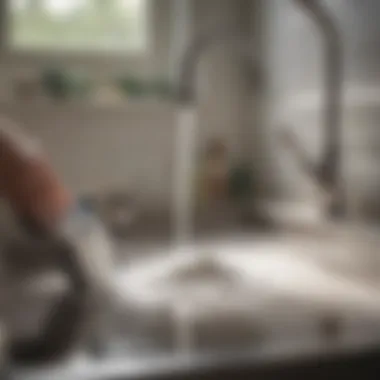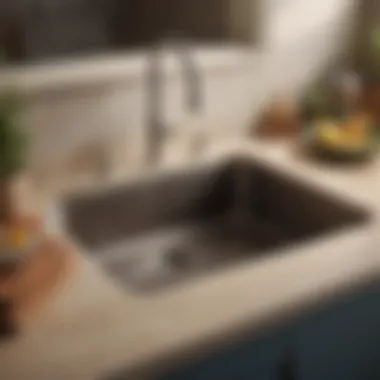Natural Solutions for Unclogging Your Kitchen Sink


Intro
Clogged kitchen sinks can be an infuriating challenge for any homeowner. Instead of relying on harsh chemicals, exploring natural methods offers a sustainable and effective approach to this common issue. Many individuals prefer these eco-friendly alternatives, not only to safeguard their plumbing systems but also to protect the environment. This guide delves into various strategies, utilizing simple household ingredients along with preventive measures. Readers will gain the knowledge they need to maintain smooth-functioning sinks without resorting to damaging chemicals.
Feature Spotlight
Effective Natural Methods
Many natural solutions can effectively address clogs in kitchen sinks. Some of the methods include:
- Baking Soda and Vinegar: This classic combination works wonders.
- Boiling Water: Sometimes, all it takes is hot water.
- Salt and Baking Soda: Another powerful duo!
- Pour half a cup of baking soda into the drain.
- Follow it with half a cup of vinegar.
- Wait for 30 minutes, then flush with hot water.
- Boil a kettle of water.
- Pour it directly down the drain in stages.
- This method helps dissolve grease or soap that may be causing the blockage.
- Mix equal parts of salt and baking soda.
- Pour it into the drain and let it sit for about 15 minutes.
- Flush with hot water afterward for optimal results.
Preventive Measures
Prevention is vital in maintaining a healthy kitchen sink. Understanding what can contribute to clogs helps in taking proactive steps. Consider implementing the following tips:
- Use a Drain Screen: Prevent food particles from entering the drain.
- Avoid Fats and Oils: These substances solidify in pipes, leading to blockages.
- Regular Maintenance: Regularly flush the drain with hot water to keep build-up at bay.
End
Adopting natural methods to unclog your kitchen sink can contribute significantly to a more sustainable household. These strategies not only save you from potential plumbing issues but also align with eco-friendly practices. By exploring the effectiveness of commonly available household items, learning how to tackle clogs, and incorporating regular maintenance routines, readers will feel equipped to face any plumbing challenges, ensuring their kitchen sink remains in optimal condition.
Understanding Kitchen Sink Clogs
Understanding the intricacies of kitchen sink clogs is essential for any homeowner or renter who seeks to maintain a functional and efficient kitchen. Clogs can lead to frustration, foul odors, and potential water damage. Knowing how clogs form and their common causes allows individuals to take proactive measures in preventing them. This section explores the elements that contribute to clogs and highlights the benefits of understanding these factors.
Clogs in kitchen sinks often arise from a combination of solid waste accumulation, grease buildup, and foreign objects. Recognizing these contributors can lead to better maintenance practices and thus prolong the lifespan of your plumbing system. Understanding kitchen sink clogs empowers homeowners to recognize early signs of blockages and take corrective actions before it escalates into a severe problem, which might require professional intervention.
Additionally, maintaining awareness about clogs encourages a more conscious use of kitchen sinks. From choosing appropriate foods to dispose of in sinks, to employing preventative strategies, each effort can reduce the frequency of clogs. Being informed also allows for more effective responses should a clog occur, minimizing time and money spent on solutions.
"Proactive maintenance can save homeowners significant time and costs associated with emergency plumbing services."
This section illustrates the crucial role of understanding kitchen sink clogs as part of ongoing home maintenance, providing the foundation for effective unclogging methods to be discussed further in this guide.
Common Causes of Clogs
Common kitchen sink clogs arise from various sources, many originating in the kitchen itself. One prevalent cause is the accumulation of food particles. Over time, small bits of food can build up and combine with grease, leading to a substantial blockage. Grease is another significant contributor, often stemming from cooking oil or fatty foods that solidify in pipes.
Other frequent causes include:
- Hair and soap residue: Though more commonly associated with bathroom sinks, stray hair can find its way into kitchen drains, especially if washed down with greasy dishes.
- Foreign objects: Utensils or small items accidentally dropped into the sink can create immediate clogs.
- Mineral buildup: Hard water can lead to lime scale accumulation inside pipes, narrowing the flow and facilitating future clogs.
Awareness of these common causes can help homeowners adjust their daily habits for better maintenance.
When to Seek Professional Help


Although there are many natural methods for unclogging sinks, there are times when professional assistance is necessary. Homeowners should consider seeking help when:
- Multiple drains are clogged: This often indicates a larger issue in the plumbing system, possibly a main sewer line blockage.
- Repeated clogs: If a sink becomes clogged constantly, it may signal an underlying problem that requires expert inspection.
- Unpleasant odors: Foul smells may indicate decay or other issues in the plumbing, suggesting a need for professional intervention.
- Inability to clear the clog: If natural methods fail, relying on a plumber with specialized tools and expertise can resolve the tension.
Understanding these scenarios allows homeowners to make informed decisions about when to rely on their skills and when to trust a professional's expertise. Immediate action in flagging significant plumbing issues ensures that your kitchen remains a safe and efficient space.
Natural Unclogging Techniques
Natural unclogging techniques play an essential role in addressing kitchen sink blockages. Utilizing these methods not only promotes a sustainable approach but also minimizes the potential harm to plumbing systems compared to harsh chemical alternatives. By focusing on simple household items, individuals can effectively tackle common clogs while preserving their environment and health.
Baking Soda and Vinegar Method
Baking soda and vinegar method is one of the most popular natural techniques for unclogging sinks. It is effective because the reaction between these two substances can break down grease and debris that often contribute to clogs.
Step-by-Step Instructions
To begin, pour one cup of baking soda into the sink drain followed by one cup of vinegar. Allow the mixture to fizz and work its magic for approximately 30 minutes. Afterward, flush the drain with hot water. This method is beneficial because both baking soda and vinegar are easily accessible in most households, making it a convenient choice. Additionally, this approach is safe for your plumbing system and poses no risk to the environment. However, a disadvantage could be that it may not resolve more severe blockages.
Expected Reactions
The expected reaction from combining baking soda and vinegar is a fizzing action, which occurs when the two substances interact. This reaction produces carbon dioxide, which can help to dislodge debris from the pipes. It is popular due to its simplicity and effectiveness concerning minor clogs. This chemical reaction, being an eco-friendly solution, does not involve caustic substances, thus preserving your plumbing. The only downside is it might not be effective for deeper, more extensive clogs.
Boiling Water Approach
The boiling water approach is a straightforward method that can effectively clear minor clogs caused by grease or soap residue. The importance of achieving the correct temperature cannot be overstated; boiling water should be used, as simmers do not provide the necessary heat to aid melting grease effectively.
Importance of Temperature
Hot water's ability to dissolve buildup is significant in unclogging. This method requires heating water until it reaches a rolling boil. As the water is poured down the drain, it can break apart and wash away accumulated substances. Even though it is a beneficial method due to its simplicity and effectiveness, caution should be taken with certain plumbing systems, as extreme heat can damage older pipes.
Limitations of This Method
While boiling water can prove effective, its limitations should be recognized. For instance, this method may not be effective against solid or stubborn blockages such as hair or large food particles. It primarily addresses grease clogs, leaving other potential issues unresolved.
Salt and Baking Soda Combination
Using a combination of salt and baking soda can also be an effective method for unclogging sinks. This mixture works well due to the abrasive nature of salt in combination with the decomposing abilities of baking soda.
Preparation and Application
To apply this method, mix one cup of salt with one cup of baking soda, and pour it into the drain. Let this combination sit for around 30 minutes, followed by flushing it with boiling water. This method is popular for its ease of preparation and application. The ingredients are typically already found in the kitchen, making this process efficient. One drawback is that this may not work on severe blockages, requiring additional methods to achieve full effectiveness.
Effectiveness over Time
The effectiveness of this combination over time can vary based on usage frequency and the type of clogs encountered. If applied regularly as part of a home maintenance routine, it can help keep drains clear and reduce the chances of clog formation. However, reliance solely on this technique may fail in addressing deep-rooted issues or more substantial clogs.
Using Dish Soap for Grease Clogs
Dish soap is a valuable ally when it comes to tackling grease clogs in kitchen sinks. Its effectiveness largely stems from its ability to break down oily and fatty substances.
Why Dish Soap Works
Dish soap works primarily due to its surfactant properties. When mixed with hot water, it can emulsify grease, allowing it to flow more freely down the drain. This method is appealing because it effectively targets grease clogs, a common issue in kitchens. However, this may not be the solution for blockages caused by solid waste or non-greasy materials.


Application Techniques
To apply this method, begin by adding a few tablespoons of dish soap down the drain. Follow this with hot water. The combination allows for a thorough cleansing of the pipes. This technique stands out for its simplicity and ease of use, particularly when encountering grease-based clogs. Still, it is essential to remember that while this may allevate minor issues, it may not resolve larger, more complex clogs.
Preventing Future Clogs
Preventing clogs in your kitchen sink is essential for maintaining a functioning plumbing system. Regular attention to this aspect will save time and reduce the stress associated with unexpected hitches. Knowing how to prevent clogs can enhance the performance of your drainage system, which, in turn, can prolong the life of your plumbing and appliances. Adopting proactive measures increases the efficiency of your kitchen and helps you avoid costly repairs down the line.
Routine Maintenance Tips
Implementing routine maintenance is vital to prevent clogs in kitchen sinks. A few simple practices can help maintain a clear drain. Here are some recommendations:
- Hot Water Flush: Regularly pouring hot water down the drain can help dissolve grease and food particles that may build up over time.
- Strainer Use: Install a strainer or mesh cover over your drain to trap food debris and prevent it from entering the pipes.
- Regular Cleaning: Periodically clean your sink and the surrounding area to minimize residue buildup. Waste can easily accumulate, leading to more significant issues later.
- Be Mindful of What Goes Down: Avoid disposing of starchy or fibrous materials, like potato peels or eggshells, in the sink. These can create problematic solids that contribute to clogs.
By incorporating these simple steps into your routine, you can significantly minimize the risks of experienceing a clog. This not only saves time but also fosters a more enjoyable kitchen experience.
Understanding Drainage System
To effectively prevent future clogs, it is important to understand how your drainage system works. Familiarity with the components will help you maintain it better. In general, the drainage system includes:
- Pipes: These are the pathways through which water and waste flow. Pipes can be composed of various materials, with some being more prone to clogs than others.
- Trap: This section of the plumbing is designed to hold water and prevent gas odor from entering your home. However, it can also collect debris over time.
- Vent System: Proper airflow contributes to the effective movement of waste and water. A blocked vent can lead to slow draining and increases clog risks.
- Main Drain Line: This is the primary route through which wastewater exits your home. If this line becomes blocked, the effects can be serious throughout your plumbing system.
Understanding these elements is crucial. When you know how your system functions, you can take smarter steps to maintain it. Regular inspection and cleaning can keep your drainage efficient and reduce the chance of problems in the future. Emphasizing maintenance leads to longer-lasting kitchen plumbing.
Tools for Natural Clog Removal
Natural methods for unclogging your kitchen sink can greatly benefit from the right tools. While household ingredients are effective, having the right equipment can enhance the effectiveness of these techniques. Tools can help you reach deeper clogs that simple substances cannot. It is essential to understand how to use them and when they can be most beneficial.
Plumber's Snake
The plumber's snake, or drain snake, is a fundamental tool for dealing with stubborn clogs. This flexible, coiled device allows you to reach deep into pipes and remove blockages that other methods might miss. It works by mechanically breaking up the clog or retrieving debris that is stuck in the pipes.
Using a plumber's snake is straightforward. You insert one end of the snake into the drain and push it until you feel resistance. Then, rotate the handle to allow the snake to latch onto the clog. This action pulls or breaks apart whatever is causing the obstruction, allowing water to flow freely again. The snake can be especially useful in kitchen sinks clogged by food particles or grease accumulation.
However, consider the following when using a plumber's snake:
- Skill Level: Familiarity with plumbing tools is necessary for effective use. A careful approach will prevent potential damage to your pipes.
- Type of Clog: A snake works best for solid blockages but may not be as effective for liquid clogs or invasive roots.
- Size and Depth of Pipes: Make sure the snake is appropriate for your pipe size, and understand that deeper pipes may require a longer snake.
Wet/Dry Vacuum Usage
A wet/dry vacuum can be an invaluable ally in the fight against kitchen sink clogs. It serves two main purposes: it can suck out clogging debris and, when used appropriately, can create suction to free blockages.
To use a wet/dry vacuum effectively, follow these steps:
- Remove standing water from the sink using the vacuum.
- Set the vacuum to the liquid setting if applicable.
- Place the vacuum hose into the drain, creating a tight seal if possible.
- Turn on the vacuum and allow it to run for several minutes.
Considerations when using a wet/dry vacuum include:
- Capacity: Ensure the vacuum has enough power to handle the size of the clog.
- Seal: A good seal is imperative for suction to work effectively.
- Potential Mess: Prepare for spillage or debris outside the sink when using this method, as it may dislodge materials.
Both tools can enhance your ability to unclog kitchen sinks using natural methods. They reduce dependence on chemical solutions and improve the chances of a successful unclogging.
Environmental Considerations


The topic of environmental considerations is critical in understanding the impact of our actions on the planet. In this context, focusing on natural methods for unclogging kitchen sinks highlights sustainable practices. These methods not only address immediate plumbing issues but also promote a healthier environment. Our plumbing choices contribute to broader ecological consequences, making it essential to choose wisely.
Most commonly used chemical drain cleaners can have detrimental effects on the environment. They often contain harsh ingredients that can leach into waterways, harming aquatic life and disrupting ecosystems. By embracing natural solutions, we can mitigate these risks while effectively solving clog issues.
Benefits of Natural Solutions
Natural solutions for unclogging kitchen sinks offer various benefits, not just for the environment but also for our health.
- Non-Toxic: Using simple ingredients like baking soda and vinegar eliminates the risks associated with toxic chemical cleaners.
- Eco-Friendly: These alternatives are biodegradable and often made from renewable resources, making them less harmful to the planet.
- Cost-Effective: Household items typically used in these solutions are often less expensive compared to chemical products.
- Safe for Plumbing: Natural methods are gentler on pipes, reducing the likelihood of corrosion or damage over time.
Overall, natural solutions reduce the ecological footprint, ensuring that plumbing maintenance aligns with sustainable living.
Avoiding Chemical Drain Cleaners
Chemical drain cleaners, while sometimes effective, carry numerous drawbacks that warrant consideration. Many individuals may not be aware of the long-term implications of their use.
- Health Risks: Exposure to chemical fumes can be hazardous, especially for children and pets.
- Potential Damage: Repeated use of chemical cleaners can weaken pipes, leading to costly repairs or replacements.
- Environmental Harm: These substances often end up in wastewater systems, where they can disrupt local ecosystems.
Residents should take a proactive stance against the temptation to resort to chemical products. Exploring natural and preventative options can save both health and environment. Over time, making these simple shifts not only enhances the longevity of home plumbing systems but also contributes to a healthier planet.
When to Use Chemical Solutions
While the focus of this guide is on natural methods for unclogging kitchen sinks, there are situations where chemical solutions become necessary. Recognizing when to make this choice is crucial for maintaining your plumbing effectively. Using chemicals should always be a last resort after attempting natural techniques. However, sometimes clogs can be stubborn, and specific circumstances can justify their use.
Identifying Severe Clogs
Severe clogs often present themselves through a range of indicators. Here are some signs indicating a clog has escalated:
- Slow Draining: Water takes an unusually long time to drain. This might indicate a significant buildup.
- Standing Water: If your sink is filled with stagnant water that fails to drain, it is a clear sign of obstruction.
- Unpleasant Odors: Foul smells can emanate from a clogged sink, often due to decomposing food or other organic matter trapped within the pipes.
- Gurgling Sounds: Sounds coming from the drain may signify that air is trying to escape through a severe blockage.
When you recognize these indicators, it is prudent to reassess the situation. Natural methods may not suffice, and chemical solutions might be needed to clear the blockage effectively.
Choosing the Right Product
If chemical solutions are necessary, selecting the appropriate product is essential. Not all drain cleaners are created equal, and some can cause harm to your plumbing system or the environment. Here are some factors to consider:
- Type of Clog: Determine the nature of the clog. Is it due to grease, hair, or other debris? Some products target specific types of clogs more effectively.
- Ingredients: Look for cleaners that are less harsh. Products that contain sodium hydroxide or sulfuric acid can do the job, but they pose risks to your pipes and health if not handled properly.
- Eco-Friendly Options: Whenever possible, opt for biodegradable or eco-friendly solutions. These options can minimize environmental impact while being effective against clogs.
- Instructions: Follow the manufacturer’s instructions carefully. Dosage and application techniques are vital for ensuring safety and effectiveness.
"Using chemicals should always be a last resort after attempting natural methods."
Concluding Thoughts
Exploring natural methods for unclogging your kitchen sink is not just about addressing an immediate problem; it is a vital practice for sustainable home maintenance. The importance of this topic lies in its ability to empower homeowners with effective and eco-friendly strategies. Not only does this approach reduce reliance on harsh chemical cleaners, but it also promotes a healthier living environment. Such methods contribute to the longevity of plumbing systems and minimize the negative impact on local ecosystems.
Summary of Natural Methods
In summary, various natural methods can effectively address kitchen sink clogs. The most notable include:
- Baking Soda and Vinegar Method: This creates a chemical reaction that can dissolve minor clogs.
- Boiling Water Approach: It can melt away grease and soap build-up effectively.
- Salt and Baking Soda Combination: This mixture can be an effective preventive measure against clogs.
- Using Dish Soap for Grease Clogs: It can break down thick grease, easing drainage issues.
Each of these methods has merits and can vary in effectiveness based on the specific clog. Regular application of these natural techniques can lead to a more efficient disposal system in your kitchen sink.
Final Recommendations
To maximize the effectiveness of these natural methods, consider the following recommendations:
- Establish a Routine: Implement regular cleaning of your kitchen sink using these methods. This will prevent build-up and clogs from occurring.
- Monitor Drain Use: Be mindful of what is discarded down the sink. Avoid placing fibrous, oily, or starchy foods in disposal systems.
- Utilize Preventive Mixtures: Periodically use the baking soda and vinegar method as a preventive measure in addition to your normal cleaning routine.
Engaging in these practices will keep your kitchen sink functional while promoting a greener lifestyle. By utilizing natural methods, you benefit both your plumbing and the planet.







